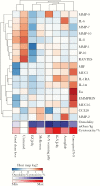Personal and Clinical Vaginal Lubricants: Impact on Local Vaginal Microenvironment and Implications for Epithelial Cell Host Response and Barrier Function
- PMID: 31539059
- PMCID: PMC6834067
- DOI: 10.1093/infdis/jiz412
Personal and Clinical Vaginal Lubricants: Impact on Local Vaginal Microenvironment and Implications for Epithelial Cell Host Response and Barrier Function
Abstract
Background: A majority of US women report past use of vaginal lubricants to enhance the ease and comfort of intimate sexual activities. Lubricants are also administered frequently in clinical practice. We sought to investigate if hyperosmolar lubricants are toxic to the vaginal mucosal epithelia.
Methods: We tested a panel of commercially available lubricants across a range of osmolalities in human monolayer vaginal epithelial cell (VEC) culture and a robust 3-dimensional (3-D) VEC model. The impact of each lubricant on cellular morphology, cytotoxicity, barrier targets, and the induction of inflammatory mediators was examined. Conceptrol, containing nonoxynol-9, was used as a cytotoxicity control.
Results: We observed a loss of intercellular connections, and condensation of chromatin, with increasing lubricant osmolality. EZ Jelly, K-Y Jelly, Astroglide, and Conceptrol induced cytotoxicity in both models at 24 hours. There was a strong positive correlation (r = 0.7326) between lubricant osmolality and cytotoxicity in monolayer VECs, and cell viability was reduced in VECs exposed to all the lubricants tested for 24 hours, except McKesson. Notably, select lubricants altered cell viability, barrier targets, and inflammatory mediators in 3-D VECs.
Conclusions: These findings indicate that hyperosmolar lubricants alter VEC morphology and are selectively cytotoxic, inflammatory, and barrier disrupting in the 3-D VEC model.
Keywords: 3-D cell culture; cytotoxicity; genital inflammation; human vaginal epithelial cells; inflammatory mediators; nonoxynol-9; vaginal lubricants.
© The Author(s) 2019. Published by Oxford University Press for the Infectious Diseases Society of America. All rights reserved. For permissions, e-mail: journals.permissions@oup.com.
Figures




References
-
- Herbenick D, Reece M, Sanders SA, Dodge B, Ghassemi A, Fortenberry JD. Women’s vibrator use in sexual partnerships: results from a nationally representative survey in the United States. J Sex Marital Ther 2010; 36:49–65. - PubMed
-
- Brown JM, Hess KL, Brown S, Murphy C, Waldman AL, Hezareh M. Intravaginal practices and risk of bacterial vaginosis and candidiasis infection among a cohort of women in the United States. Obstet Gynecol 2013; 121:773–80. - PubMed
-
- Gallo MF, Sharma A, Bukusi EA, et al. . Intravaginal practices among female sex workers in Kibera, Kenya. Sex Transm Infect 2010; 86:318–22. - PubMed
-
- Hassan WM, Lavreys L, Chohan V, et al. . Associations between intravaginal practices and bacterial vaginosis in Kenyan female sex workers without symptoms of vaginal infections. Sex Transm Dis 2007; 34:384–8. - PubMed
-
- Leiblum SR, Hayes RD, Wanser RA, Nelson JS. Vaginal dryness: a comparison of prevalence and interventions in 11 countries. J Sex Med 2009; 6:2425–33. - PubMed
Publication types
MeSH terms
Substances
Grants and funding
LinkOut - more resources
Full Text Sources
Medical
Miscellaneous

